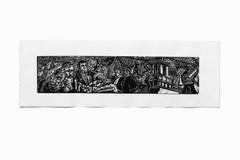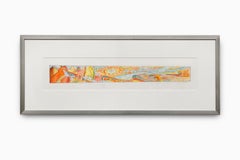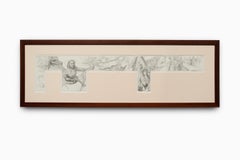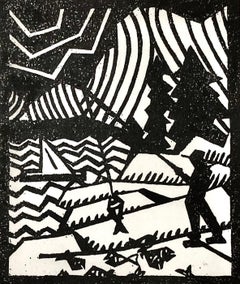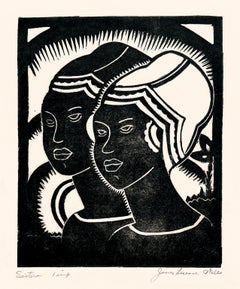Hubert Massey Art
to
3
3
2
1
"History of Detroit" Linoleum Cut, Black Ink, African American, Mural Style
By Hubert Massey
Located in Detroit, MI
"History of Detroit" is in the style of a mural by the master muralist from the city of Detroit, Hubert Massey. It renders in dramatic composition the ov...
Category
Early 2000s American Modern Hubert Massey Art
Materials
Linocut
"Mexicantown: Bagley Bridge" Proposal Drawing for Tile Mosaic, Watercolor
By Hubert Massey
Located in Detroit, MI
"Mexicantown: Bagley Bridge" is a proposal drawing for a mural completed by Hubert Massey in 2016. It is colorfully rendered on paper with color pencil a...
Category
2010s Contemporary Hubert Massey Art
Materials
Paper, Watercolor, Color Pencil
"Earth, Wind, Fire, and Water" Proposal Drawing for Mural, Figurative, Pencil
By Hubert Massey
Located in Detroit, MI
This enchanting mural proposal done with graphite is exemplary of Hubert Massey's style. Within the piece pre-industrial civilization finds itself side-b...
Category
Early 2000s Contemporary Hubert Massey Art
Materials
Paper, Graphite
Related Items
Martha Reed, (Fishing)
By Martha Reed
Located in New York, NY
Martha Reed was the daughter of the artist Doel Reed and as an adult she joined her parents in Taos, New Mexico.
There she designed clothes with a south-we...
Category
Mid-20th Century American Modern Hubert Massey Art
Materials
Linocut
'Sisters' — Renowned Black American, Harlem Renaissance Artist
Located in Myrtle Beach, SC
James Lesesne Wells, 'Sisters', linocut, edition not stated but small, 1928. Signed, titled, and annotated 'imp' in pencil. A fine impression on off-white wove Japan paper, with wide margins (1 7/8 to 3 3/4 inches), in excellent condition. Printed by the artist. Very scarce. Matted to museum standards, unframed.
Image size 8 3/16 x 6 3/4 inches (208 x 171 mm); sheet size 13 1/2 x 10 3/4 inches (343 x 273 mm).
Exhibition and Literature: 'Narratives of African American Art and Identity: The David C. Driskell Collection,' The Art Gallery at the University of Maryland, extensive touring exhibition, 1998-2000.
Collections: Pennsylvania Academy of the Fine Arts, Smithsonian Institution (Anacostia Community Museum).
ABOUT THE ARTIST
“Wells is more than an artist with a deep concern for his fellow man. He carries many of his themes a step further into an apocalyptic world, a world of revelation and shifting lights. … He works on large blocks in a bold free style. … His work has a vigor, therefore, that is not often used in the medium today.”
—Jacob Kainen (painter, critic, and collector) from Richard J. Powell’s 1986 essay Phoenix Ascending: The Art of James Lesesne Wells.
James Lesesne Wells was an American painter, printmaker, educator, and pioneering figure of the Harlem Renaissance, whose work established a vital connection between African heritage, modernist form, and African American cultural identity. Known for his innovative use of linoleum and woodblock printing, Wells played a key role in shaping 20th-century African American art and inspired countless students throughout his lengthy career as a teacher at Howard University.
Born in Atlanta, Georgia, Wells' early exposure to the arts came through church and community, where African American cultural traditions were central. He pursued formal artistic training at Lincoln University in Pennsylvania (earning a B.A. in 1924), followed by studies at the Pennsylvania Academy of the Fine Arts and the Barnes Foundation, where he encountered European modernists as well as traditional African sculpture, which profoundly influenced his style.
Wells moved to New York in the late 1920s, swiftly immersing himself in the lively artistic and intellectual scene of Harlem. There, he became associated with artists, writers, and thinkers of the Harlem Renaissance, contributing to the growth of Black cultural identity. Considered a mentor to many famed artists of the Harlem Renaissance, Wells served as director of a summer art workshop in Harlem where his assistants included Charles Alston, Jacob Lawrence, and Palmer Hayden...
Category
1920s American Modern Hubert Massey Art
Materials
Linocut
$3,500
H 8.19 in W 6.75 in
Prodigal Son
By Thomas Hart Benton
Located in London, GB
A man raises his hand to his chin, his neck tilted and face turned to look at a dilapidated farmhouse, barely held together by planks of wood and exposed to the elements. Behind him ...
Category
1930s American Modern Hubert Massey Art
Materials
Lithograph
'Modern Music' — WPA Modernism, New York City El
Located in Myrtle Beach, SC
Albert Potter, 'Modern Music' also Twilight Melodies', linocut, c. 1935, from the posthumous edition of 20, printed in 1977, authorized by the artist’s widow. Estate authenticated in...
Category
1930s American Modern Hubert Massey Art
Materials
Linocut
Down the River
By Thomas Hart Benton
Located in London, GB
In this sentimental work from 1939, Benton expresses his admiration for the rural lifestyle of the Midwest. He highlights the connection between man and the land by depicting two fig...
Category
1930s American Modern Hubert Massey Art
Materials
Lithograph
Discussion
By Thomas Hart Benton
Located in London, GB
In this charming regionalist lithograph, Benton captures a classic Midwestern American scene: two men talking, drinking, and smoking together in a bar. Titled 'Discussion', the artwo...
Category
1930s American Modern Hubert Massey Art
Materials
Lithograph
"Labor in a Diesel Plant" Machine Age American Scene Industrial Mid 20th Century
By Letterio Calapai
Located in New York, NY
"Labor in a Diesel Plant" Machine Age American Scene Industrial Mid 20th Century
Letterio Calapai (American 1902-1993)
''Labor in A Diesel Plant''
Wood engraving, 1940
17 x 10 1/2...
Category
1940s American Modern Hubert Massey Art
Materials
Lithograph
$6,900
H 23 in W 16 in D 2 in
"Hotel Lobby, " Linoleum Cut by Alexander Tillotson
Located in Milwaukee, WI
"Hotel Lobby" is a linoleum print by Alexander Tillotson. It features the view of a hotel lobby from the viewpoint of the back of two men. Thick lines and minimal negative space give...
Category
1930s American Modern Hubert Massey Art
Materials
Linocut
$1,283
H 14.25 in W 13.31 in
Harold E. Keeler, Water Fall
Located in New York, NY
Harold E. Keeler worked in Hollywood as a set designer. That seems especially important here because the Water Fall looks a little as though it could be a w...
Category
1930s American Modern Hubert Massey Art
Materials
Linocut
"Swimmers, " Seascape Linoleum Cut by Clarice George Logan
By Clarice George Logan
Located in Milwaukee, WI
"Swimmers" is an original linoleum print by Clarice George Logan. It features five figures enjoying a swim, jumping off from a small boat.
Image: 4.94" x 6"
Framed: 13.87" x 14.87"
Clarice George Logan was born in Mayville, New York in 1909 but moved to Wisconsin in 1921. She attended the Milwaukee State Teachers College from 1927 to 1931 where she studied with Robert von Neumann...
Category
1930s American Modern Hubert Massey Art
Materials
Linocut
$1,285
H 13.87 in W 14.87 in
Old Man Reading
By Thomas Hart Benton
Located in London, GB
Accompanied by a lantern, an elderly man sits alone, engrossed in a newspaper. Benton used a lithographic process to draw and produce this image. He renders the face and paper well-l...
Category
1940s American Modern Hubert Massey Art
Materials
Lithograph
Barbara Latham 1950s Modernist Linocut “Saturday Morning, Taos Plaza”
By Barbara Latham
Located in Denver, CO
A vibrant celebration of Taos life and culture, Saturday Morning (Market, Taos Plaza, New Mexico) is a striking 1950s modernist linocut print by acclaimed New Mexico artist Barbara L...
Category
Mid-20th Century American Modern Hubert Massey Art
Materials
Linocut
$1,650
H 16 in W 17.75 in
Hubert Massey art for sale on 1stDibs.
Find a wide variety of authentic Hubert Massey art available for sale on 1stDibs. You can also browse by medium to find art by Hubert Massey in paper, pencil, color pencil and more. Much of the original work by this artist or collective was created during the 21st century and contemporary and is mostly associated with the contemporary style. Not every interior allows for large Hubert Massey art, so small editions measuring 28 inches across are available. Customers who are interested in this artist might also find the work of Frank Kleinholz, Yasuo Kuniyoshi, and Cecil Crosley Bell. Hubert Massey art prices can differ depending upon medium, time period and other attributes. On 1stDibs, the price for these items starts at $5,400 and tops out at $22,000, while the average work can sell for $11,000.
